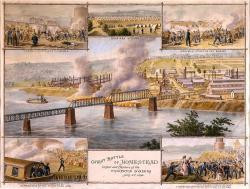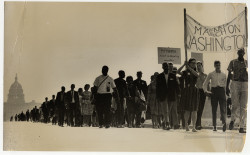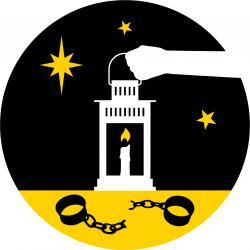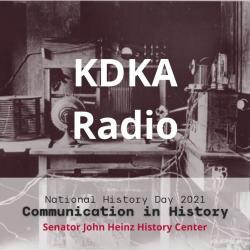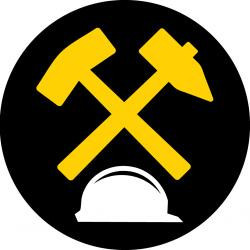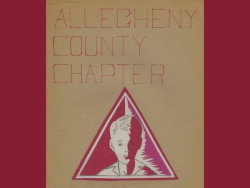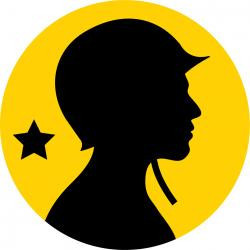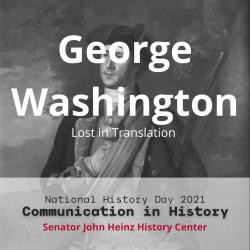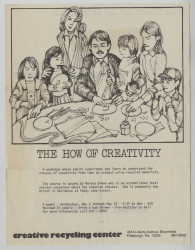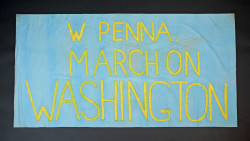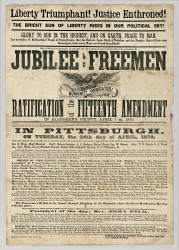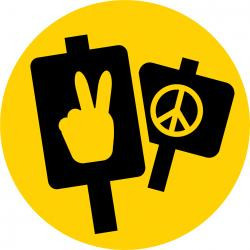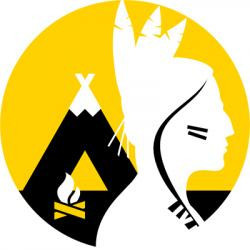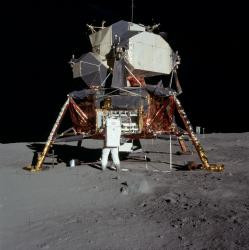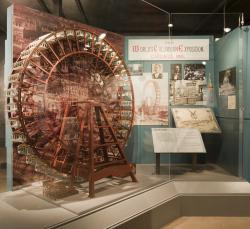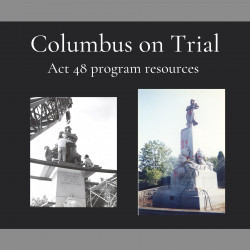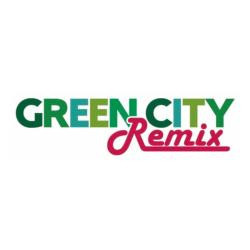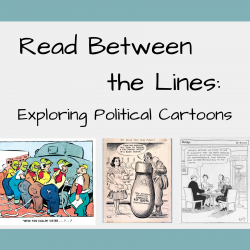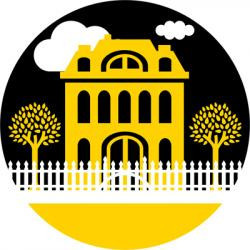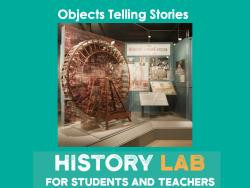Senator John Heinz History Center's collections
Conflict and Compromise: Pittsburgh's Labor History
<p>This collection connects the 2018 National History Day theme of "Conflict and Compromise in History" to a selection of labor strikes that occurred in Western Pennsylvania. This region has a long history of labor strikes, some of which led to successful negotiations, while others led to violence. The collection also includes information about the <em>Pittsburgh Survey</em> to illuminate the living and working conditions that were often the reasons that compelled workers to strike.</p>
<p>These objects, images, and sources can be used to help form an idea for a project, provide a new angle on an existing project idea, or lead to new ways of including primary sources into NHD projects. The Heinz History Center blog features additional information about the <a href="http://www.heinzhistorycenter.org/blog/western-pennsylvania-history/homestead-steel-strike" target="_blank" style="background-color:rgb(63,63,63);">Homestead Strike</a> and <a href="http://www.heinzhistorycenter.org/blog/western-pennsylvania-history/picturing-protest-great-railroad-strike-1877" target="_blank" style="background-color:rgb(63,63,63);">Railroad Strike</a> images.</p>
<p>#NHD2018 #NHD</p>
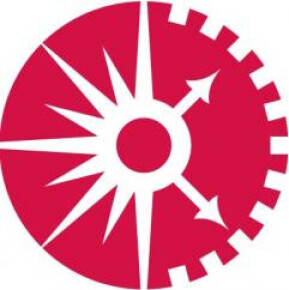 Senator John Heinz History Center
Senator John Heinz History Center
22
Triumph and Tragedy: Pittsburgh's History of Innovation in Science
<p>This collection connects the 2019 National History Day theme of "Triumph and Tragedy in History" to a selection of topics related to Western Pennsylvania, science, and innovation. This region’s history features many stories of triumph over tragedy, including two key events: the creation of the polio vaccine at the University of Pittsburgh, and Rachel Carson’s fight against the detrimental effects of pesticides on the environment.</p>
<p>The first half of the collection focuses on the story of the polio vaccine, including context on the polio virus, movements to raise money for a cure, and Salk's work in Pittsburgh. It also mentions Henrietta Lacks, whose cells were used without permission for a range of medical advancements, including the polio vaccine.</p>
<p>The second half of the collection highlights Rachel Carson, her talent for writing and interest in animals as a child, how she came to be interested in the effects of DDT, and her legacy as an environmentalist. </p>
<p>These objects, images, and sources can be used to help form an idea for a project, provide a new angle on an existing project idea, or lead to new ways of including primary sources into NHD projects. They are drawn from a range of primary source repositories, which can be helpful sources of information for students working on these topics. <br /></p>
<p>#NHD2019 #NHD </p>
 Senator John Heinz History Center
Senator John Heinz History Center
35
Civic Discourse: Social Justice Issues
<p>This collection was created as part of the Civic Discourse in a Digital World teacher institute in June of 2021. It is designed to highlight a selection of materials related to social justice from the Heinz History Center and the Detre Library & Archives collections. </p>
<p>How do these sources connect to civic discourse? </p>
<p>Choose a topic section and use the Think/Puzzle/Explore thinking routine to think deeper about these important issues. </p>
<p>#civicdiscourse</p>
 Senator John Heinz History Center
Senator John Heinz History Center
40
Creating Social Change: Advocating for People with Disabilities
<p>This collection highlights some of the key documents in the Bob Nelkin Collection of ACC-PARC Records that help us to understand the steps he and his fellow advocates took to end the "warehousing" of children and adults with disabilities in institutions. </p>
<p>Formed in 1951, the ACC-PARC was a grassroots organization made up of parents of people with disabilities in the Pittsburgh area. The aspect of ACC-PARC’s daily activities most represented in these primary sources are the efforts of the advocates to investigate the treatment of individuals with disabilities at residential care facilities in Western Pennsylvania during the 1960s and 1970s.</p>
<p>This Learning Lab collection showcases some of the work of ACC-PARC as they advocated for change in institutions throughout Western Pennsylvania. Each section addresses a specific step or tactic used by these advocates. Instructional materials and activities are provided throughout the collection.</p>
<p></p>
<p>The primary sources in this Learning Lab collection are housed at the Heinz History Center's Detre Library and Archives in Pittsburgh, PA:</p>
<p><a href="https://historicpittsburgh.org/collection/nelkin-acc-parc-records" target="_blank"><strong>Bob Nelkin Collection of Allegheny County Chapter of the Pennsylvania Association for Retarded Children (ACC-PARC) Records,</strong></a><strong><a href="https://historicpittsburgh.org/collection/nelkin-acc-parc-records" target="_blank"> MSS 1002, Detre Library and Archives, Heinz History Center</a>.</strong><br></p>
<p>The creation of this lesson plan was underwritten by the United Way of Allegheny County.<br><br></p>
 Senator John Heinz History Center
Senator John Heinz History Center
41
Soul Soldiers: African Americans and the Vietnam Era
<p><strong><em>Soul Soldiers: African Americans and the Vietnam Era </em></strong>explores the events of civil rights and the Vietnam War as they impacted African American life and culture. The mid 1950s to the 1970s was an era of great change in America as new social, political, and cultural perspectives began to reshape the American landscape. In Vietnam and at home, African Americans were impacted by these events resulting in a greater expression of political and cultural identity. This was the era of street demonstrations and court battles; of protest and musical expression; of Black arts and Black Power. African American men and women, <em>Soul Soldiers,</em> battled on two fronts, for equality at home and democracy abroad. Their service in war was valor and their activism in civil rights was historic.</p>
<p>This collection of materials was designed by the Heinz History Center for classroom use. Be sure to click on the info tab and/or paperclip icon on each time for additional information and suggested learning activities. </p>
 Senator John Heinz History Center
Senator John Heinz History Center
24
National History Day 2021: George Washington
<p>This collection connects the 2021 National History Day theme of "Communication in History" to the events that led up to the beginning of the French, British and Indian War and the Seven Years' War. During the 18th century, Western Pennsylvania was the western frontier of what would become the United States of America. Pittsburgh's three rivers were the gateway to the interior for the French and the British. The French and British both laid claim to this area and continued to struggle for control of it. This Learning Lab collection can be used to spark an idea for an NHD project or as a resource for an existing project.</p>
 Senator John Heinz History Center
Senator John Heinz History Center
13
Pittsburgh Youth Activism
<p><em>Pittsburgh Youth Activism e</em>xplores the history of youth activism in Pittsburgh and Western Pennsylvania. Specific examples include Pittsburghers who participated in the 1964 Freedom Summer voter registration campaign in Mississippi and the 1968 Wilkinsburg race riots. This teaching resource includes two parts: a primary source exploration and conversation and the call to action. Be sure to click on the paper clip and/or info icon on each item to find out more about it. </p>
 Senator John Heinz History Center
Senator John Heinz History Center
15
Between Two Worlds: Western Pennsylvania’s American Indians, 1700 - 1820
<p>This curriculum pack was produced by the Historical Society of Western Pennsylvania and includes everything you need to teach about relationships between Native Americans and Europeans in the frontier of western Pennsylvania. The student text includes readings that you can give directly to your students, and the info tabs on items throughout the collection includes suggested teaching activities. Primary sources and biographies are also included (be sure to click on the paper clip and/or info icon on each item to find out more about it).</p>
 Senator John Heinz History Center
Senator John Heinz History Center
32
Innovation and Invention: Alcoa and the Lunar Module
<p>This Learning Lab collection is designed to accompany the Heinz History Center's Innovation and Invention virtual program. In the program, students learn the story of Alcoa and the contributions this Pittsburgh company made to the world. This activity dives deeper into one particular Alcoa innovation - the legs of the lunar module that first landed men on the Moon. <br></p>
<p>The activity is based on <a href="https://pbskids.org/designsquad/build/touchdown/">"Touchdown," created by PBS Kids Design Squad.</a> It was adapted by the Heinz History Center to include the story of the Alcoa aluminum innovation used for the legs of the Lunar Module. </p>
 Senator John Heinz History Center
Senator John Heinz History Center
5
Perpetrating the Holocaust: Gaining an Understanding through Archives
<p>This activity uses a restitution document and graphic organizer to help students understand who perpetrated the actions of the Holocaust, particularly as it affected the Weikers family. The Weikers family papers are held in the Detre Library and Archives at the Heinz History Center in Pittsburgh. The archive document comes from the Weikers Family collection, and the accompanying graphic organizers were created by Heinz History Center education staff. More images and documents connected with this family story are available on the <em><a href="http://www.jewishfamilieshistory.org/entry/weikers-family/">Generation to Generation: Family Stories Drawn from the Rauh Jewish Archives</a> </em>website. </p>
 Senator John Heinz History Center
Senator John Heinz History Center
8
Green City Remix: Pittsburgh's Smoke Control Campaign
<p>Green City Remix was a collaborative project of the Green Building Alliance and the Senator John Heinz History Center to create exhibits developed and designed by local high school students. In the 1940s efforts were made to combat Pittsburgh’s reputation as the nation’s smoky city, changing both air quality and the city’s image. Using the Allegheny Conference on Community Development collection in the Detre Library and Archives, students researched the Smoke Control campaign, which included legislation passed by city government in 1941 that significantly improved Pittsburgh’s air quality by regulating factors such as fuel sources and the equipment used in industry and in homes.</p>
<p>Through a visit to the Green Building Alliance and conversations with local activists, the students explored ways in which Pittsburgh can continue to improve on its legacy as a smoky city. Students examined art installations at The Mattress Factory and with the help of local artist, Danny Bracken, designed art installations <em>remixing </em>the story of Smoke Control in a way that demonstrates its relevance to today. </p>
<p>This collection includes primary source materials used by the students to explore Pittsburgh's response to air quality challenges. How might these resources inspire your own students to explore the ways changes is made in their city?</p>
 Senator John Heinz History Center
Senator John Heinz History Center
26
From Plantation to Pittsburgh: The Great Migration and Pittsburgh
 Senator John Heinz History Center
Senator John Heinz History Center
13

